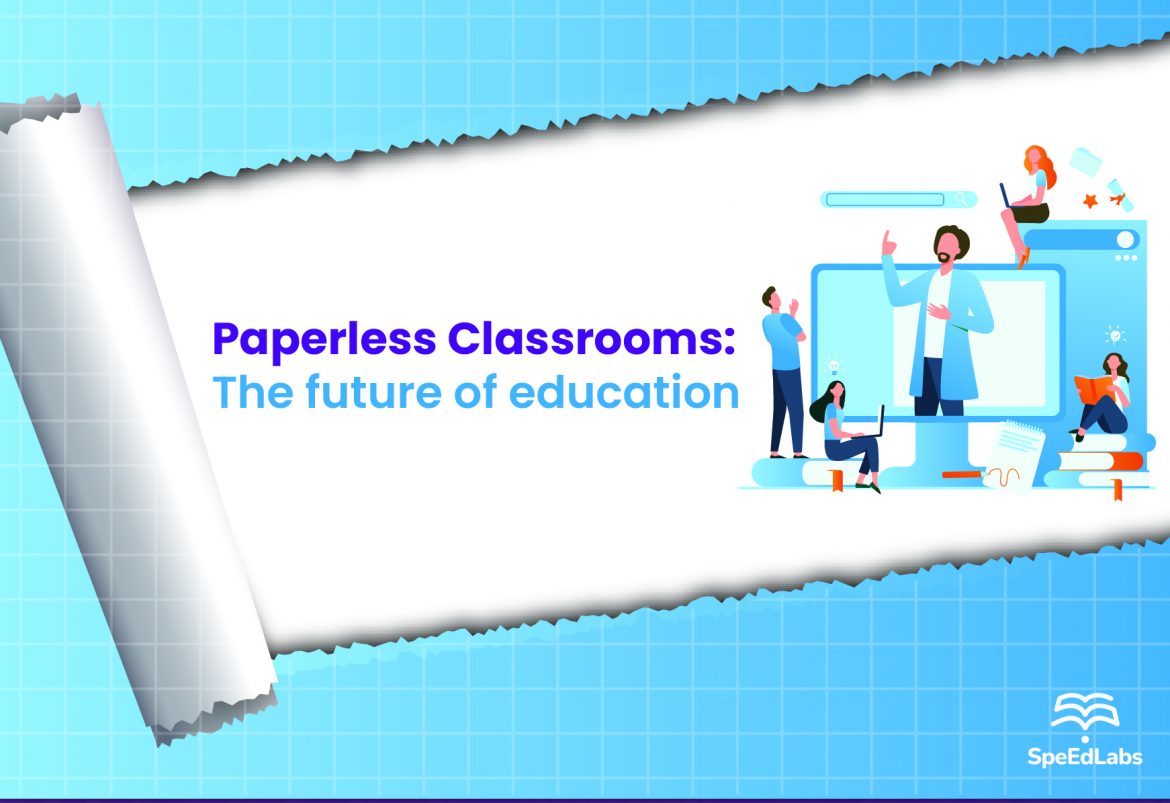Rising use of technology in classrooms: The post-pandemic world needs an efficient, digitally empowered set-up for education.
Technology is continuously evolving day by day and is present almost everywhere today. The academic sector has also seen a tremendous shift from conventional pen-paper classrooms to present-day digital classrooms. Gone were the days when schools used to have only a few computers equipped labs, nowadays every classroom is VR/AR-based and laptops have replaced square systems.
The shape of progression of technology: Paperless classrooms
Paperless classrooms Have you ever imagined a school completely free from the use of paper? That is e-books, personal laptops or tablets for attending lectures, smartboards, etc. If yes, then is it possible? How would it look? What are the advantages/ disadvantages of the same? In this blog, we will try to answer all these questions and will learn more about paperless classrooms.
Surprisingly, a paperless classroom is still an unrealistic concept at least for a developing country like India where people prefer reading and writing in a physical mode much more than in virtual/digital format. Setting up a paperless classroom is a bit of a complex process because the entire curriculum needs to be converted in digitized mode and thereafter, its transfer into cloud-based storage is required so that students can access it wherever and whenever they want.
Let us now discuss the advantages associated with paperless classrooms.
Advantages:
- Time is money: Time-consuming processes are simplified when paperless classrooms are built. Such types of classrooms can be a boon for school administration because they need to handle numerous documents throughout the day like circulars, fee statements, files, etc. and there are chances that these may get lost causing severe troubles. Not only this, printing tasks, letters to the home of students, etc. can consume a lot of time and energy. The paperless mode can be an alternative to all these allowing management officials to invest their time in other important beneficiaries for students.
- Saves resources: Lakhs of rupees are spent every year in schools on paper and related products. These paper products are used in issuing receipts, exam copies, circulars to students, as printer sheets, etc. Purchase of all these resources can be prevented when a school switches to a paperless environment. Plus, lots of money can be saved every year and this money could cover advancements in technology, support students in their projects, infrastructure development with more facilities, etc.
- Environmental benefits: This point is self-understanding. When negligible or no paper will be used, the environment will stay free from any sort of damage. The deforestation graph will decline and we will be living in a healthy environment. Many of you must have seen piles of waste paper products lying either in the classroom or any other place on your institute’s campus. Is that right? Being paperless also prevents the spread of paper litter and in this way, premises can be made clean.
- Organized structure: Sometimes, misplacement of information takes place due to collective work being done on paper. This is not at all possible with paperless classrooms because every student can be assigned information/tasks individually on his/her personalized dashboard. In addition to this, documents get secured as they will be accessed using encrypted e-lockers only. So, chances of stealing or misplacement are impossible. Teachers/staff can access these documents anywhere on the premises and in case of any emergency, the deletion process is possible with the click of a button.
Having this many advantages does not mean that paperless classrooms have no disadvantages. Some of the disadvantages of paperless classrooms are:
- Financially not feasible: With paperless classrooms, school fees will increase because of the increase in facilities like Digital boards, e-labs, etc. as they require more power to work upon. Even demand for personal systems will rise among students so that they can attend lectures, do assignments, etc. All this can disturb the budget of many families. To prevent this, schools must opt for generalized student information systems and provide laptops/tabs for those students who can’t afford to do so.
- The Difficulty for specially-abled students: For students with special needs, the interaction of traditional classrooms is required. Technical literacy can act as a challenge for such students and hence learning becomes very difficult. Special provisions must be taken into consideration for specially-abled students so that they can also match the pace with other students.
- Loss of live interaction: Some students always prefer face-to-face interaction with their teachers when lecture takes place. But this problem can be solved up to a certain extent with the use of meeting platforms like Skype, internet conferences, etc.
Key Takeaways
To conclude, there are numerous benefits of going paperless and this should be implemented in schools for both the betterment of students as well as to ensure a structured classroom.
Also published on Medium.
